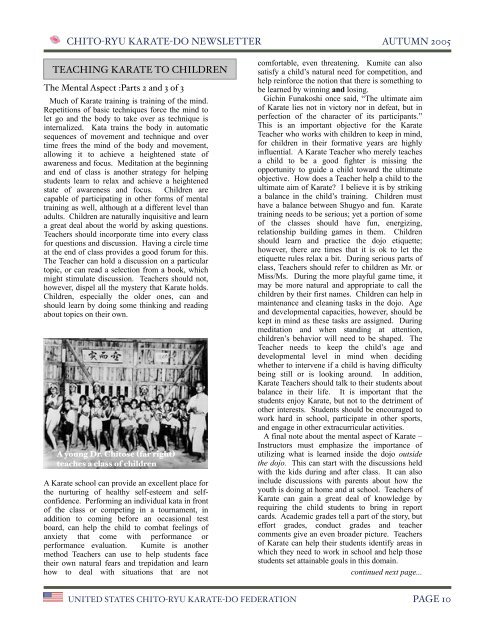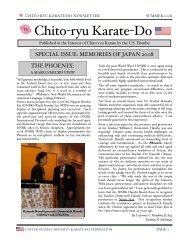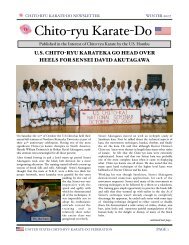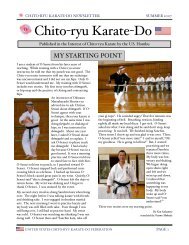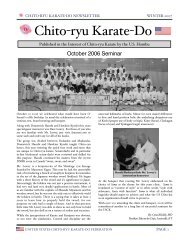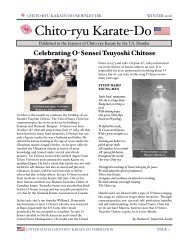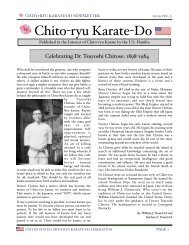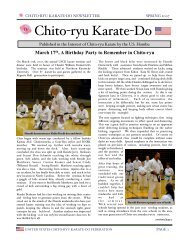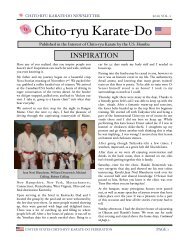Confucius - United States Chito-ryu Karate Federation
Confucius - United States Chito-ryu Karate Federation
Confucius - United States Chito-ryu Karate Federation
Create successful ePaper yourself
Turn your PDF publications into a flip-book with our unique Google optimized e-Paper software.
CHITO-RYU KARATE-DO NEWSLETTER AUTUMN 2005<br />
TEACHING KARATE TO CHILDREN<br />
The Mental Aspect :Parts 2 and 3 of 3<br />
Much of <strong>Karate</strong> training is training of the mind.<br />
Repetitions of basic techniques force the mind to<br />
let go and the body to take over as technique is<br />
internalized. Kata trains the body in automatic<br />
sequences of movement and technique and over<br />
time frees the mind of the body and movement,<br />
allowing it to achieve a heightened state of<br />
awareness and focus. Meditation at the beginning<br />
and end of class is another strategy for helping<br />
students learn to relax and achieve a heightened<br />
state of awareness and focus. Children are<br />
capable of participating in other forms of mental<br />
training as well, although at a different level than<br />
adults. Children are naturally inquisitive and learn<br />
a great deal about the world by asking questions.<br />
Teachers should incorporate time into every class<br />
for questions and discussion. Having a circle time<br />
at the end of class provides a good forum for this.<br />
The Teacher can hold a discussion on a particular<br />
topic, or can read a selection from a book, which<br />
might stimulate discussion. Teachers should not,<br />
however, dispel all the mystery that <strong>Karate</strong> holds.<br />
Children, especially the older ones, can and<br />
should learn by doing some thinking and reading<br />
about topics on their own.<br />
A young Dr. <strong>Chito</strong>se (far right)<br />
teaches a class of children<br />
A <strong>Karate</strong> school can provide an excellent place for<br />
the nurturing of healthy self-esteem and selfconfidence.<br />
Performing an individual kata in front<br />
of the class or competing in a tournament, in<br />
addition to coming before an occasional test<br />
board, can help the child to combat feelings of<br />
anxiety that come with performance or<br />
performance evaluation. Kumite is another<br />
method Teachers can use to help students face<br />
their own natural fears and trepidation and learn<br />
how to deal with situations that are not<br />
comfortable, even threatening. Kumite can also<br />
satisfy a child’s natural need for competition, and<br />
help reinforce the notion that there is something to<br />
be learned by winning and losing.<br />
Gichin Funakoshi once said, “The ultimate aim<br />
of <strong>Karate</strong> lies not in victory nor in defeat, but in<br />
perfection of the character of its participants.”<br />
This is an important objective for the <strong>Karate</strong><br />
Teacher who works with children to keep in mind,<br />
for children in their formative years are highly<br />
influential. A <strong>Karate</strong> Teacher who merely teaches<br />
a child to be a good fighter is missing the<br />
opportunity to guide a child toward the ultimate<br />
objective. How does a Teacher help a child to the<br />
ultimate aim of <strong>Karate</strong>? I believe it is by striking<br />
a balance in the child’s training. Children must<br />
have a balance between Shugyo and fun. <strong>Karate</strong><br />
training needs to be serious; yet a portion of some<br />
of the classes should have fun, energizing,<br />
relationship building games in them. Children<br />
should learn and practice the dojo etiquette;<br />
however, there are times that it is ok to let the<br />
etiquette rules relax a bit. During serious parts of<br />
class, Teachers should refer to children as Mr. or<br />
Miss/Ms. During the more playful game time, it<br />
may be more natural and appropriate to call the<br />
children by their first names. Children can help in<br />
maintenance and cleaning tasks in the dojo. Age<br />
and developmental capacities, however, should be<br />
kept in mind as these tasks are assigned. During<br />
meditation and when standing at attention,<br />
children’s behavior will need to be shaped. The<br />
Teacher needs to keep the child’s age and<br />
developmental level in mind when deciding<br />
whether to intervene if a child is having difficulty<br />
being still or is looking around. In addition,<br />
<strong>Karate</strong> Teachers should talk to their students about<br />
balance in their life. It is important that the<br />
students enjoy <strong>Karate</strong>, but not to the detriment of<br />
other interests. Students should be encouraged to<br />
work hard in school, participate in other sports,<br />
and engage in other extracurricular activities.<br />
A final note about the mental aspect of <strong>Karate</strong> –<br />
Instructors must emphasize the importance of<br />
utilizing what is learned inside the dojo outside<br />
the dojo. This can start with the discussions held<br />
with the kids during and after class. It can also<br />
include discussions with parents about how the<br />
youth is doing at home and at school. Teachers of<br />
<strong>Karate</strong> can gain a great deal of knowledge by<br />
requiring the child students to bring in report<br />
cards. Academic grades tell a part of the story, but<br />
effort grades, conduct grades and teacher<br />
comments give an even broader picture. Teachers<br />
of <strong>Karate</strong> can help their students identify areas in<br />
which they need to work in school and help those<br />
students set attainable goals in this domain.<br />
continued next page...<br />
UNITED STATES CHITO-RYU KARATE-DO FEDERATION PAGE 10


